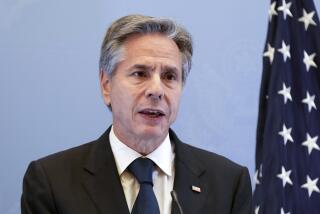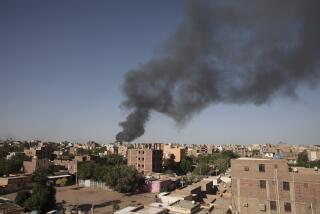500 Americans Staying Behind : Gulf crisis: Only 14 U.S. citizens take advantage of the latest airlift from Kuwait and Iraq. Others are believed still in hiding or are choosing to remain.
- Share via
BAGHDAD, Iraq — The final mass evacuation of Westerners brought 318 Britons and only 14 Americans out of Kuwait and Iraq on Tuesday night. The paltry number of departing U.S. citizens suggested that about 500 Americans have chosen to stay on or are unaccounted for in either Iraq or occupied Kuwait.
Among these are people who remain in “deep hiding” or who have chosen to stay because they are married to Kuwaiti or Iraqi citizens, or those who have established homes here, U.S. officials believe.
“Based on the evidence of today’s flight, we believe that all Americans who wish to depart will have done so,” State Department spokesman Richard Boucher told reporters in Washington.
“We’ll probably try to do one more flight Thursday,” said Joseph C. Wilson IV, the senior U.S. Embassy official in Baghdad. “But we’ll not be getting big planeloads, I don’t believe.”
W. Nathaniel Howell III, the U.S. ambassador in Kuwait, and his small staff, who have stayed defiantly inside the beleaguered compound, may be on the Thursday flight, U.S. officials here said. If so, their departure will effectively shut down the American Embassy in the Iraqi-occupied capital.
“This business of expecting everyone to come out in a few days is unrealistic,” said Jeanette C. Pina, the U.S. Embassy consular officer in Baghdad. “I really expect a trickle (of Americans to emerge from Kuwait) for the next six months.”
Altogether, nearly 500 foreigners flew out of Iraq on Tuesday. The Britons and Americans were aboard two Iraqi civilian jetliners, one an American charter bound for Frankfurt, Germany, with seven Americans and a sprinkling of other nationalities aboard, the other a British charter bound for London carrying seven Americans and more than 300 Britons. After overnighting, the Americans are expected to continue to the United States today.
A third airliner, chartered by the Japanese government, also left the Iraqi capital Tuesday, carrying 159 people, including 15 Japanese diplomats from Kuwait, the rest mostly Japanese ex-hostages.
Some of the departing Westerners, although constrained by the fact that they had not yet taken off from Baghdad, spoke of their experiences in captivity. “The people who deserve the greatest admiration are the Kuwaitis who sheltered us despite the fact that they could be executed on the spot if they were found helping us,” the Associated Press quoted 61-year-old Briton Ken Emsden as saying.
Emsden said that gunfire can still be heard in Kuwait city every night and that he saw the bodies of four civilians in the street Tuesday morning.
So far, fewer than 200 Americans have departed from the two countries since the first of the current wave of refugee airlifts began on Saturday.
Since the Persian Gulf crisis took shape in the wake of Iraq’s invasion of Kuwait on Aug. 2, about 2,700 Americans have left Iraq and Kuwait. The first to leave were women and children, who were under no restrictions.
Most of the American men, however--the bulk of them in Kuwait--quickly found themselves denied permission to leave, and dozens were rounded up and sent under guard to strategic sites in Iraq to function as so-called human shields against a possible U.S. attack. Their freedom was delayed until last Thursday, when Iraqi President Saddam Hussein announced that all foreign hostages would be freed.
All but one of the Americans held as human shields have now been evacuated. The remaining person is Gary O’Connor of Humble, Tex., who still must go to Basra in southern Iraq to obtain the proper work-release documents from his employer, U.S. officials said.
Four other U.S. citizens were unable to leave Baghdad on Tuesday aboard either of the two chartered airliners--either because they lacked the proper work documents in order to qualify for an exit visa from Iraq or because their Kuwaiti or Iraqi wives still must obtain additional paperwork before being allowed to leave.
Pina said the embassy staff will concentrate on getting their paperwork in order today.
Underscoring the fact that some Americans remain unaccounted for, the U.S. government-sponsored Voice of America this week broadcast a message to Kuwait urging four specific Americans to get in touch with the State Department.
Julian Gill of White Plains, N.Y., the sole American to flee from Kuwait on Tuesday, said he had heard unconfirmed reports there that several U.S. citizens had been shot.
Gill, a marketing consultant who has lived in Kuwait on and off for more than a decade, also said that some Americans may have died while trying to escape across the Kuwaiti desert or may have actually succeeded.
The U.S. Embassy in Baghdad had chartered an Iraqi Airways jet with 175 seats to fly to Kuwait on Tuesday. But it returned to Baghdad Tuesday night with only two Canadians and one Irishman. The lone American from Kuwait flew to Baghdad on one of the two British-chartered round-trip flights between Baghdad and Kuwait. The other 13 Americans who flew out were from Iraq.
There are still 200 Britons remaining in Iraq and 100 in Kuwait, according to Caroline Cross, the British consul here. “Of those, we don’t know how many want to stay or leave,” she said.
“This is our last scheduled charter as of now,” Cross said at the Saddam International Airport on Tuesday night.
Wilson, the senior American diplomat in Baghdad, hailed the mass departures of Westerners as “a success for reason.”
Virtually forgotten amid the evacuations that began Saturday are the tens of thousands of other foreigners, mostly Asians, who remain in Iraq and Kuwait, unable to go home largely because of economic reasons.
Among them are more than 7,000 Vietnamese contract laborers, 8,000 to 10,000 Indians and thousands more Pakistanis and Bangladeshis, foreign diplomats here said Tuesday.
“Don’t think the hostage issue is solved,” cautioned one high-ranking foreign embassy official here. “Saddam Hussein still has thousands of hostages in his hands. Don’t think he’s an idiot.”
Nearly 1,000 Vietnamese already have flown home, but due to their sheer number it may take weeks to get the rest out, diplomats said.
“Nobody seems to care about them,” fumed one senior embassy official from a country in the anti-Iraq alliance. “The Indian government isn’t even sending a plane or anything.”
There are also about 2,800 Soviet workers still in southern Iraq’s oil fields, according to the Soviet Embassy here. More than 5,000 other Soviets already have been evacuated, including 420 on Thursday and Sunday.
Moscow is scrambling to get the remaining ones out before the Jan. 15 deadline set by the U.N. Security Council for Iraq to withdraw from Kuwait. After that date, the U.N. resolution authorizes the use of military force to liberate Kuwait.
“We are very concerned about them,” a Soviet Embassy official said Tuesday.
Officials at the embassies of India and Vietnam were not available for comment Tuesday.
Asians still trapped in Kuwait and Iraq range from merchants and contract laborers to drivers and other service workers, most of whom cannot afford to leave, according to diplomats here. Others include foreign nationals who are married to local citizens who themselves may be barred from leaving, they said.
Many of the contract workers cannot leave because of business obligations to Iraq; they would be able to leave only if they are replaced by other fellow nationals.
Turkey, which has evacuated about 7,000 of its citizens from Iraq and Kuwait, still has 38 workers guarding their equipment at an Iraqi dam construction site.
More to Read
Sign up for Essential California
The most important California stories and recommendations in your inbox every morning.
You may occasionally receive promotional content from the Los Angeles Times.










